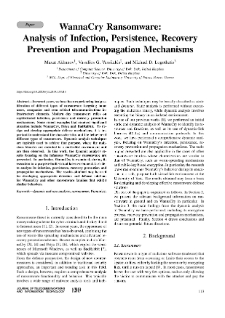Instytut Łączności – Państwowy Instytut Badawczy contains 2 319 digital objects
Object
Title: WannaCry Ransomware: Analysis of Infection, Persistence, Recovery Prevention and Propagation Mechanisms, Journal of Telecommunications and Information Technology, 2019, nr 1
Description:
Publisher:
Instytut Łączności - Państwowy Instytut Badawczy
Format:
Resource Identifier:
ISSN 1509-4553, on-line: ISSN 1899-8852 ; oai:bc.itl.waw.pl:2076
Source:
Journal of Telecommunications and Information Technology
Language:
Rights Management:
Biblioteka Naukowa Instytutu Łączności
Object collections:
- Digital Library > Institute's Publications > Current Publications > Journal of Telecommunications and Information Technology (JTIT)
Last modified:
May 9, 2025
In our library since:
Apr 15, 2019
Number of object content hits:
219
All available object's versions:
https://ribes-54.man.poznan.pl/publication/2364
Show description in RDF format:
Show description in OAI-PMH format:
Objects Similar
Logothetis, Michael D. Vassilakis, Vassilios G. Ioulianou, Philokypros P.
Moscholios, Ioannis D. Logothetis, Michael D. Vassilakis, Vassilios G. Boucouvalas, Anthony C.
Kallos, Georgios A. Moscholios, Ioannis D. Logothetis, Michael D. Katsiva, Maria A. Vassilakis, Vassilios G.
Moscholios, Ioannis D. Vassilakis, Vassilios G. Sagkriotis, Stefanos G. Pantelis, Spyros K.
Moscholios, Ioannis D. Logothetis, Michael D. Sarigiannidis, Panagiotis G. Keramidi, Irene P.
Moscholios, Ioannis D. Logothetis, Michael D. Chousainov, Iskanter-Alexandros Panagoulias, Panagiotis I. Sarigiannidis, Panagiotis G.

